The Sting Ray Still Defines the Corvette
The C2 is one of America's most iconic automobiles and it still impacts GM today.
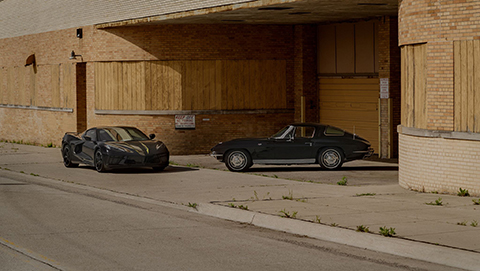
By Daniel Pund on September 13, 2021
It's possible that as a car-design inspiration, the stingray was not the best choice. Oh, they are graceful creatures, gliding along with little apparent effort. And, of course, stingrays wield switchblades near the ends of their whip-like tails. So, they embody a fierce, alien beauty and also peril. What could better describe the psychological aspirations of mid-20th-century car enthusiasts? Or, for that matter, what could better describe the naked desires of sports-car fantasies from any era?
This story originally appeared in Volume 6 of Road & Track
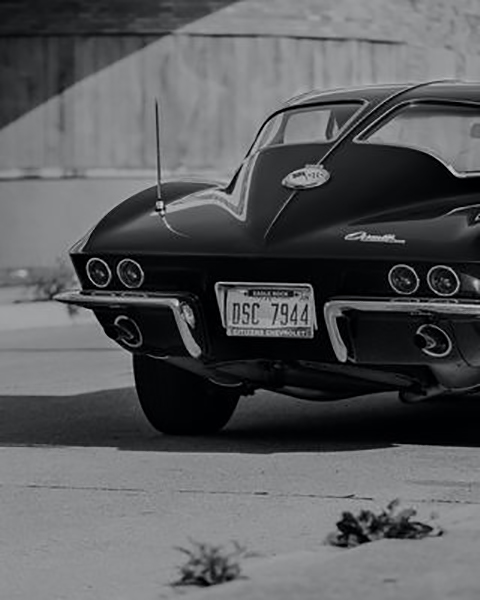
There is no more iconic Corvette design than the '63 Sting Ray split-window coupe. Visibility be damned. / Ryan Debolski
And the first production Corvette Sting Ray, inspired by Chevy's menacing Sting Ray race car, is still a captivating thing. Unlike many celebrated sports cars from the era, there is no mistaking a 1963 Sting Ray for anything else on this earth. That's particularly true when the Sting Ray happens to be a coupe, such as this handsome black-over-saddle-tan example. All so-called C2 Corvettes share a basic body shape: a sharp horizontal edge ringing the body about midway up and an edge rising over each wheel. The coupes add a gradually descending roofline that meets the flat rear deck in a boattail-like point. But only the '63 coupe possesses the styling coup de grâce: the raised knife's edge that runs from just behind the windshield header over the center of the roof and down the isthmus of bodywork that bisects the rear glass. This Sting Ray is, like the best of midcentury designs, at once soothingly familiar and bracingly radical. It achieved an Eames-chair-like timelessness its predecessors didn't. Little wonder then that such a landmark design statement should still resonate with Chevy designers. You won't see the side coves of early ('56-'62) Corvettes repeated on modern versions, much less the silly finned nubbin taillights of the earliest cars. Instead, the newest Corvette, just like the C7 it replaced, nabs the sharp fender lines and tapering canopy that have bounced around in the heads of Chevy designers like an earworm for decades. It is no coincidence that the last two generations of Corvette have carried the Stingray moniker (even if in the single-word version instead of the C2's two-word construction). The designers of this newest Corvette even considered splitting the rear glass of the C8 coupe with a strip of bodywork. After all, you need the new car's roof-mounted camera and video rearview mirror to get a decent look behind you, so less rear glass surface isn't that huge an imposition.
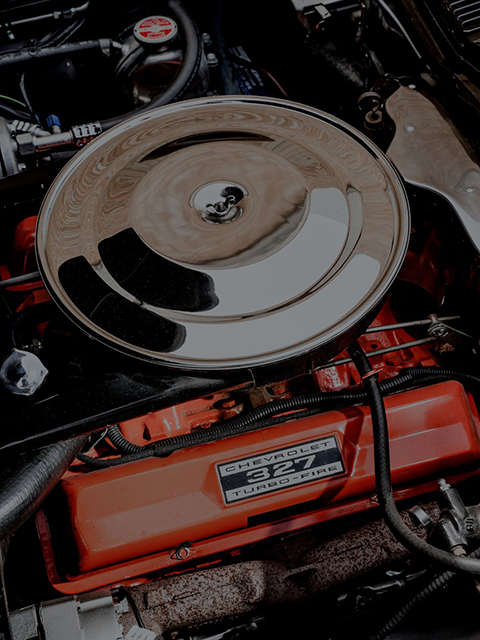
All '63 Sting Rays were powered by 327-cubic-inch small blocks. This is the 250-hp base engine. / Ryan Debolski
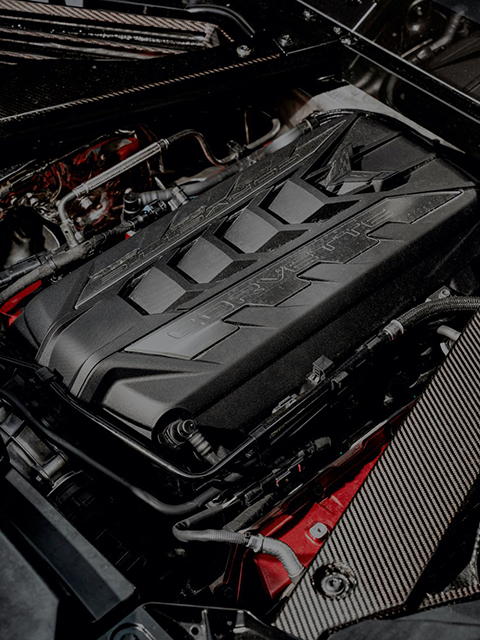
It might be behind the passenger cabin now, but the heart of the Corvette remains a pushrod V-8. / Ryan Debolski
But, in the end, the C8 Corvette looks nothing like a Sting Ray or, for that matter, a stingray. Time, fashion, and the wind tunnel have instead turned the Corvette into a horseshoe crab. It carries its visual weight low. The widest part of its finned and ridged exoskeleton sits hunkered down, skimming the ground. And so it must be. Anyone who ever tracked a C2 Corvette, or even just approached its top speed, knows of its terrifying lack of high-speed stability. As air piled up under that high, fine-edged nose, the Sting Ray tried to soar like its namesake. Attractive design isn't always functional design.
Both generations of Sting Ray/Stingray show a real affection for surface excitement, too. Planted on the old car's hood are two clearly nonfunctional "grilles." They're intended to mimic the Sting Ray racer's vents but come off looking like misplaced BBQ grates. Those, along with the split rear window, didn't survive into the 1964 model year, killed by the champions of serious performance within the Corvette fold who didn't cotton to any frivolity. The excesses of the C8's design will be harder to expunge. And here I don't mean the acid yellow/white/black interior combination or the tacky acid-yellow stripe decals on the hood. Those are easy to avoid when spec'ing your C8. But you cannot avoid the riot of errant lines radiating over the hood or that panel's leading edge—zigzags in imitation of the canopy edges of a stealth fighter. The nose and tail are fussy, with various planes crashing into one another for no apparent reason. Better overly exuberant, though, than boring.
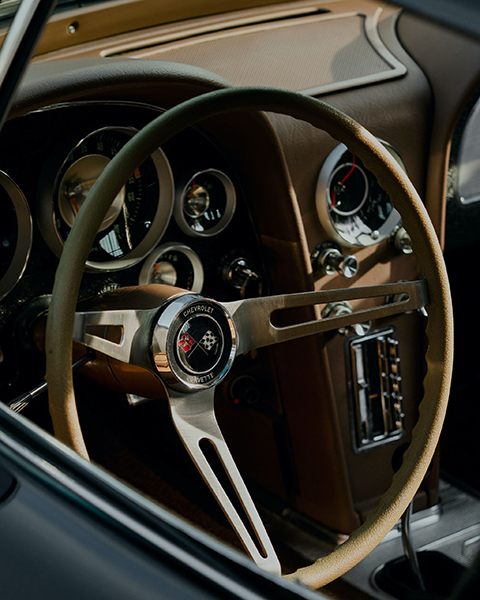
The '63's steering wheel is large enough to not block the view of the gauges. / Ryan Debolski
The old car's styling indulgences are more of the ornamental variety. The popular conception is that the mid-to-late Sixties was the period when Chevy got serious about Corvette performance. The C2 did, after all, carry the model's first independent rear suspension and would, midway through the generation's production span, get four-wheel disc brakes. But a quick look at the advertising created for the '63 reveals cross-purposes. "Instant Celebrity," a print ad from the era, features a gentleman in a hat, suit, and gray gloves (!) exiting his Tuxedo black '63 coupe while an elaborately uniformed valet bows to greet him. That's about as far from the grimy pits of Sebring as you could get. But that showboat aspect of Corvettes was always a part of the formula. It still is.
The '63 seen here is owned by former GM employee Jim Hall, but it was originally ordered by someone who might have otherwise been a Buick fan. The first owner specified leather seats, power brakes, power steering, power windows, and the base-level 250-hp 327-cubic-inch small block topped with a single Carter carburetor. That engine was bolted to the optional two-speed Powerglide automatic transmission. This daily- driver Vette is the opposite end of the '63 lineup from the big-tank Z06 track car, one of which Hall also owns.
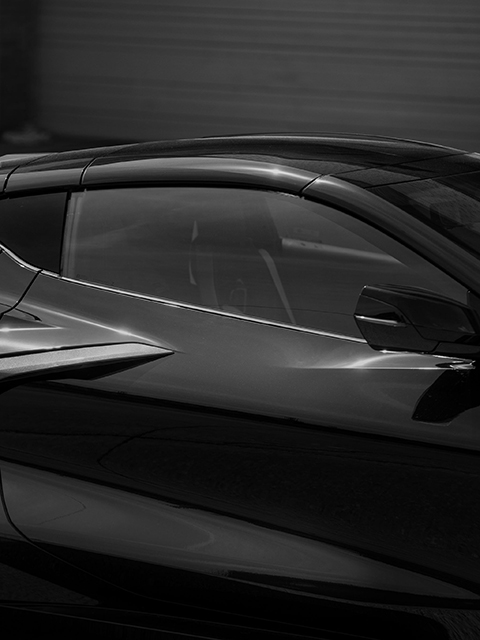
The C8's fender peaks are inspired by the old Sting Ray's. And just as on the '63, they fade into the door panel / Ryan Debolski
The '63 is an exceptionally pleasant thing to drive. Everything about it is light. Despite its close-coupled environs, there is plenty of daylight penetrating the cabin. Sitting relatively high and upright, the old car makes new sports cars, the C8 included, feel like dark bunkers. The steering wheel is impossibly large and thin rimmed by modern standards. The big wheel's leverage would come in handy if one didn't order the optional power assist. Combine that captain's wheel with the overboosted hydraulic system and the result is perhaps the lowest-effort primary control I've experienced in recent memory. Not unpleasant—but striking. The power is ample for such a relatively light car. And the engine burbles and rumbles politely without any of the theatrics of modern performance engines. The suspension feels like it has its sea legs, rolling comfortably with big-wave motions.
The new Vette, which is currently available only with the great-grandson of the '63's small-block, is not so pliant. Its engine barks on start-up. It is capable of effortless quickness. It too is an automatic, although it carries four times the number of forward gears in its box as the old car. And in place of the single rubber-band shift of the Powerglide, the modern Tremec dual-clutch automatic knocks out bunches of rapid-fire shifts that are primarily heard, not felt. It is ruthlessly efficient. It simply works with smooth precision. Eventually, this pushrod V-8, a partial anachronism even in sports cars of the Sixties, will be supplemented with electric motors and replaced by smaller-displacement double-overhead-cam turbocharged V-8s. Hell, eventually, there will almost certainly be a Corvette four-door and a Corvette crossover. Electronics have allowed for quantum leaps in performance, reliability, and comfort compared to the old car. But, in essence, the Corvette Stingray remains surprisingly consistent with its predecessors: a flamboyantly styled, two-seat GT car motivated by a naturally aspirated pushrod V-8. The automatic transmission is now a requirement instead of simply a very popular option.
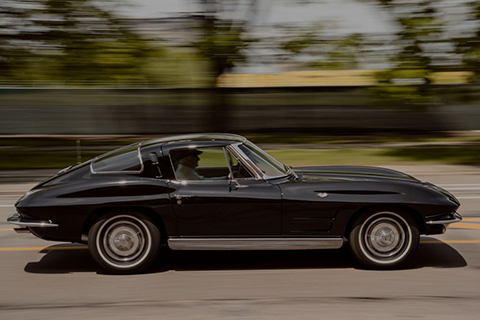
Never in the Corvette's history has the company made such a drastic change as between C1 and C2 generations. / Ryan Debolski
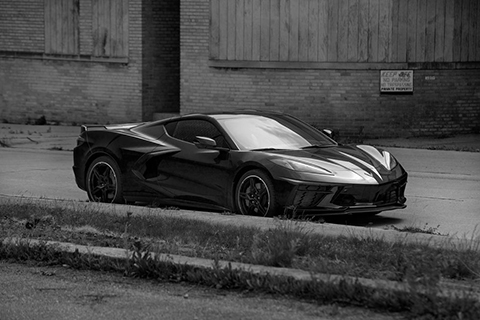
Even with its new mid-engine proportions, the C8 is immediately recognizable as a Corvette. / Ryan Debolski
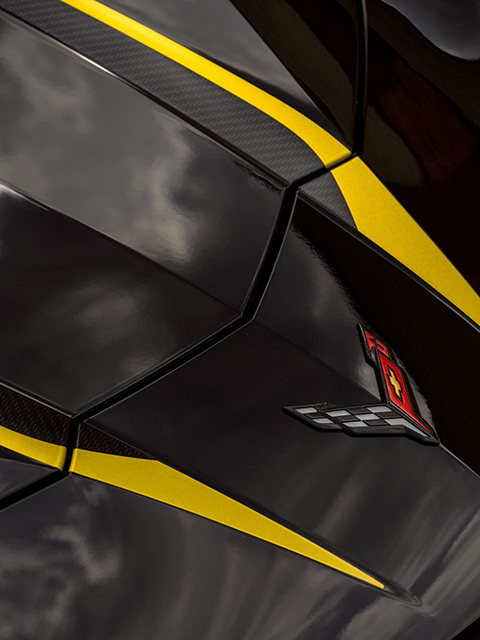
The hood's jagged cutline is a bit much. As are the optional decal stripes which feature hundreds of tiny cross-flag logos, akin to wearing a shirt with your face printed on it. / Ryan Debolski
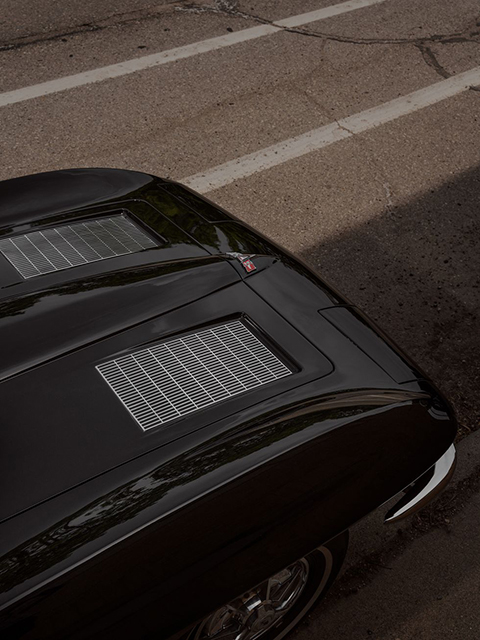
Fake hood vents prove Chevy was always tempted by filigree. They lasted only one year. / Ryan Debolski
But the differences between the two are very real and represent a notably mixed bag. No self-respecting car enthusiast would ever call the recirculating-ball steering of the old car anything but absurdly unsporting. That's particularly true when compared to the quick and precise response the new car provides through its fat-rimmed, Alcantara-swathed rectangular steering wheel. But otherwise, the new car is divorced from its mechanical nature. It feels anodyne compared to the old car. The '63 feels special, cool, even if it's packed with every nonperformance option offered on the model. I feel like I look better in the '63, a person of distinction and taste.
And just about when I've concluded that the new car is an accomplished but essentially inert thing, the '63's engine dies in a low-speed corner. And then again. And again. The combination of a closed throttle, power-steering load, and an idle that's set a little too low makes for repeated stalls. It's nothing that a slight adjustment can't take care of. That's the thing about old cars, they can run anywhere along a spectrum from "dead" to "running perfectly" at any given time. A new car, guided by computer code informed by sensors, either works or it does not. It's either a one or it's a zero. There is no 0.593 in the mix.
I'm happy on this humid, 92-degree day to hop in the new Corvette Horseshoe Crab at the end of our photo shoot, do a few full-throttle on-ramp run-ups and then ease into a comfy expressway cruise, A/C blasting away my discomfort.
1963 Chevrolet Corvette Sting Ray
Price:
$4,252 (base when new)
Engine:
5.4-liter V-8
Output:
250 hp/350 lb-ft
Transmission:
2-speed automatic
Curb Weight:
2,859 lb
2021 Chevrolet Corvette Stingray
Price:
$60,995 (base)
Engine:
6.2-liter V-8
Output:
495 hp/470 lb-ft
Transmission:
8-speed dual-clutch automatic
Curb Weight:
3,647 lb
